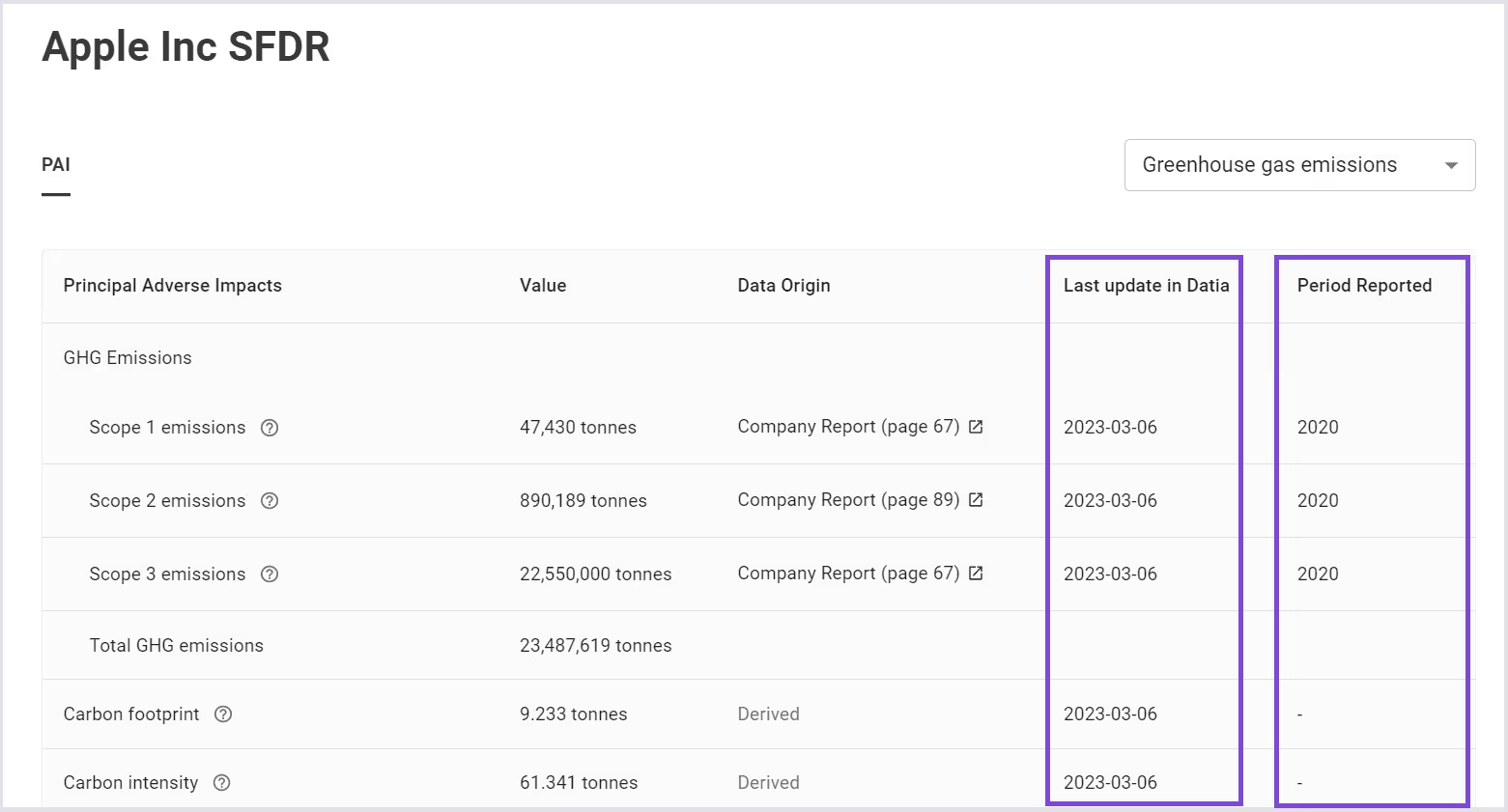Key takeaways
In our latest product updates, Datia made big steps towards incorporating a higher level of data transparency into our platform.
But why is data transparency so important?
First, disclosing the data sources and how the metrics were acquired gives your sustainability work more legitimacy.
Second, it enables asset managers to identify the holdings lagging with their reporting, and, therefore, prioritize the active ownership work.
In this article, we will take a close look at the changes made at Datia and how asset managers can make the best possible use of our data transparency initiatives to move their sustainable finance work forward.
A whole new layer of data transparency
Datia’s customers can now see SFDR’s Principal Adverse Impact (PAI) indicators paired with additional background data, including:
- Data origin
- Data recency
- Level of coverage
Below we will explain each of these information buckets.
Data origin
Data origin answers the question “how was this data acquired?”. Datia categorizes the origins of data into the following groups:
- Reported: data that comes from publicly available data, presented in documents such as sustainability or ESG reports published by companies. For some values within this category, it’s possible to trace the information to the source, e.g. specific page of a company sustainability report. And, at Datia, you can actually click on the link to the relevant portion of the document
- Estimated: values that come as a result of data processing using proprietary methodologies
- Derived: in some cases, the value of an indicator is not directly available but can be derived from publicly available sources


Data recency
Another aspect of increased data transparency is the data recency of the PAI indicators. All values have the date when they were last updated on the platform. When the origin of the value is a report, the reporting period is also shown.

Data coverage
We have made coverage visible for each PAI indicator. A PAI indicator with high data coverage is calculated based on a large amount of data from the portfolio companies. This way the well-covered indicator represents the exposure to an adverse impact to a higher degree.
In contrast, an indicator with low data coverage is calculated based on incomplete data - and, in these early days of SFDR reporting, incomplete data is considered better than no data. But it’s good to keep in mind that the exposure to the adverse impacts is not fully represented when a portfolio has low data coverage.
How asset and fund managers can use data transparency to build trust with their clients
At Datia, we understand that building trust with your customers and prospects is crucial for the growth of your funds. A comprehensive answer to the question “where does this number come from?” is key to proving your background knowledge of the ESG profile of your financial product. Asset managers want to be able to answer this question, hence the responsibility of knowing their data to the root.
Coverage would be the first thing to be aware of when presenting your funds’ sustainability numbers. Datia’s visualization of coverage shows how much data is available for the given indicator for the given portfolio. What might explain the lower coverage is often the nature of the portfolio holdings: smaller private companies who might have never reported sustainability metrics or have not followed the latest European templates.
The data origins summary for each PAI indicator is another tool to showcase the reliability of data. Reported data is the best for building trust as it’s traceable to the source. Portfolios with a higher share of public companies would often have a higher proportion of values coming directly from the companies’ reports.
However, don’t be disheartened if a certain indicator has a high proportion of estimated and derived origins. One reason to be comfortable with derived numbers on PAI indicators is that derivation is in their nature. Carbon footprint and GHG intensity are just some examples of indicators that are always derived. The calculations for these indicators consider other data points such as the value of the investment, company enterprise value, and revenue, thus will always be specific to a portfolio and cannot be reported by the company. The second reason is that modern estimation techniques are based on multiple factors and do the job of filling in the data gaps in companies' reports with a high degree of accuracy.
Dealing with uncertainty and lack of data
Data availability remains an issue for the financial markets and keeps many from embracing sustainable finance. Let’s acknowledge it - no one feels like their reports are 100% complete and covered. It can be challenging, but beneficial to communicate the data limitations in your reports shared with your customers and stakeholders. This transparency will certainly help build trust with stakeholders and demonstrate a commitment to continuous improvement.
Another approach to consider is to prioritize data collection efforts in areas where it is most critical to the organization's sustainability goals and where stakeholders are most interested in seeing progress. This can help you focus and ensure that the most important data is available and reliable.
Finally, it is important to continue working towards improving data collection and reporting processes over time. While some data will become available as the Corporate Sustainability Reporting Directive (CSRD) is being rolled out, some companies - especially smaller ones - might need additional engagement from your end.
Read Datia's team tips on how to comply with SFDR despite the data limitations.
How Datia can help
Datia is a platform tailored for professional investment teams operating under European sustainability regulations like SFDR, EU Taxonomy, and MiFID II. Independent asset managers, fund management companies (ManCos), and asset management divisions of large companies trust Datia with their reporting needs.
We are happy to help you also tackle sustainable finance data challenges. Reach out to our team of experts to learn about our platform.

.avif)
